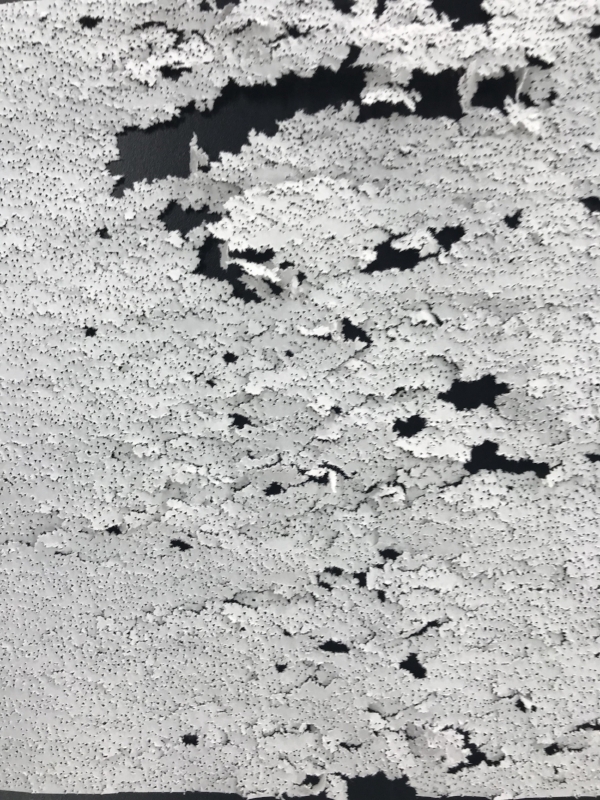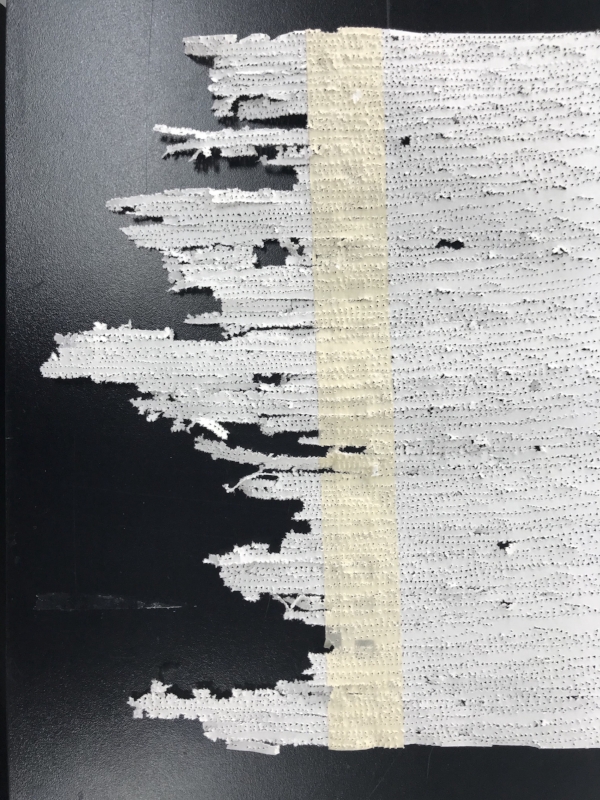At Dartmouth Avenue there is a vintage industrial felting machine in the mixed media textiles studio. It is traditionally used to felt two pieces of textiles together, but all I could think of was running all kinds of paper through it!
Vintage needle felting machine, Dartmouth Ave. mixed media textiles studio, Bath Spa University, 30 November 2017.
Vintage needle felting machine, Dartmouth Ave. mixed media textiles studio, Bath Spa University, 30 November 2017.
My interest lies in testing techniques to create degrees of opacity and translucency with manipulated paper. Piercing paper has been part of my practice through the use of a sewing machine to stitch images and sheets together. Patterns made in the paper as light shines through the piercings have been an unintended but welcomed outcome.
I wanted to see what happens with a less designed approach by simply allowing hundreds of needles to transform the paper. Would it be possible to get a more organic or at least abstract result using this machine?
Since this was a spontaneous set of tests during my induction to the machine with Stephen Daniels, I used three types of paper that I had on hand: sketchpad, vellum, and acetate. They had to be taped end-to-end to form a long enough sheet to safely pass through the needle bed.
O'Brien, K. (2017) Pierced paper tests: sketchbook paper, 30 November 2017.
O'Brien, K. (2017) Pierced paper tests: sketchbook paper (detail), 30 November 2017.
O'Brien, K. (2017) Pierced paper tests: sketchbook paper, 30 November 2017.
O'Brien, K. (2017) Pierced paper tests: vellum (detail), 30 November 2017.
O'Brien, K. (2017) Pierced paper tests: vellum (detail), 30 November 2017.
O'Brien, K. (2017) Pierced paper tests: acetate (detail), 30 November 2017.
O'Brien, K. (2017) Pierced paper tests: acetate (detail), 30 November 2017.
This is a promising start. It seems there is potential to create the effects and feelings that I seek: translucency, veiling, delicacy, vulnerability, impermanence. These initial results are satisfying, so I will continue in this vein. I am also surprised by how beautiful the destruction is from thousands of needle punches, and excited about the potential and application to my work.
For future experiments, I am interested in:
:: creating long sheets that can be draped or hung. I need to source rolls or larger sheets that are already long enough to go through the machine, or that can be attached (sewn, taped, lightly glued/lightly tacked?)
:: trying more types of paper and materials (thicker fine art paper, tissue paper, Tyvek (a synthetic American sheeting used in construction and for disposable hazmat suits), cellophane, handmade paper, plastic sheeting)
:: experimenting with color
:: text—possibly as a way of encoding hidden or secret messages
:: combining papers—run them through as two or more sheets together, layer felted and untreated pieces
:: making larger works —because the machine bed is only 16 inches wide, I will have to attach pieces together once they are felted to build larger pieces (machine stitch, hand-sew)
:: supports and frames—how will I install, suspend, drape, hang and otherwise make use of these materials?








